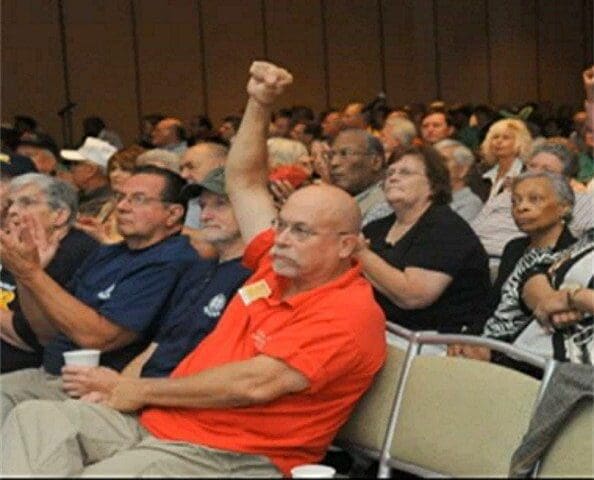
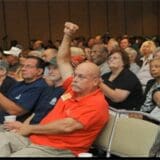
Social Security, Medicare and Medicaid are under attack by Republican lawmakers. Whether it is the Romney/Ryan budget that would end Medicare as we know it or proposals to privatize and cut Social Security, members of the Alliance for Retired Americans are pushing back and mobilizing with new “Let’s Not Be the Last Generation to Retire” campaign.
During the next few weeks to coincide with Medicare’s and Medicaid’s 47th anniversary July 30 and Social Security’s 77th on Aug. 14, Alliance members will sponsor educational briefings at senior centers and organize protests outside offices of lawmakers who have voted against the needs of local retirees. Says Alliance President Barbara Easterling:
Our goal is to educate seniors on the issues and on where elected officials and candidates stand. We need to clear up all the misinformation that is being spread by the big business groups and the right-wing commentators on TV.
» Read more about: Let’s Not Be the Last Generation to Retire »
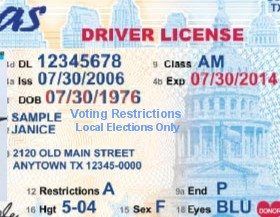
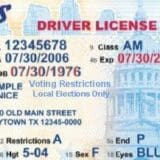
In the last two years, since the Republican sweep in the 2010 elections, GOP-controlled legislatures in many states have passed laws requiring photo identification for voters. It is widely believed that the unspoken intent of these laws is to suppress voting by groups known to be friendly to Democrats, such as African-Americans, Latinos, poor people, and young people. In a possible miscalculation, the Republicans also make it more difficult for seniors, a group that has recently trended more Republican.
Pennsylvania, has one of the toughest photo ID laws. A person must have a photo ID, such as a valid Pennsylvania driver’s license, a valid U.S. passport, or an ID issued by a Pennsylvania higher education institution or nursing home (with an expiration date). If the potential voter has none of these, s/he can obtain a state-issued card from the Department of Transportation. To do that, one must go to one of the agencies equipped to issue such cards,
» Read more about: Voter Suppression Laws: Green Cards for Citizens? »


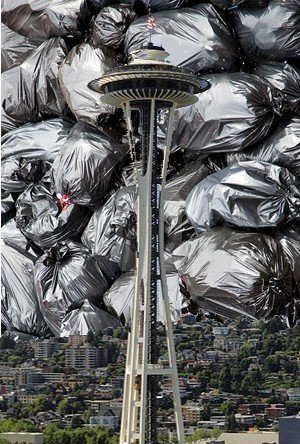 (Note: The following feature first appeared at Unionosity, a new local blog devoted to coverage of labor issues; we repost it with permission.)
(Note: The following feature first appeared at Unionosity, a new local blog devoted to coverage of labor issues; we repost it with permission.)
Negotiations between workers and the Waste Management company have reached an absolute standstill, with hundreds of trash and recycling workers striking and the sanitation giant refusing to negotiate with picketing workers.
Waste Management employees, represented by Teamsters Local 117, walked off the job last Wednesday after working without a contract since May 31. Waste Management is proposing a contract that pays recycling workers less than garbage haulers, despite the similarity between the jobs. Tellingly, Waste Management has historically taken an oppositional stance to organized labor, and seemed to be priming for a lock-out in June. After the contract expired, Waste Management held a job fair for replacement (scab) workers, and increased security at its Puget Sound headquarters. Alas,
» Read more about: Seattle Strike: Garbage In, No Garbage Out »


(Beginning tomorrow, August 1, health insurance companies will be required to cover women’s preventive care without extra charges. As other provisions of the Affordable Care Act (ACA) continue to unfold over the next few years, more women will gain further access to affordable preventive health care. Countdown to Coverage has been marking the days leading up to August 1 with posts about how ACA – often called “Obamacare” by its opponents — will benefit women, while pointedly rebranding the act “MamaCare.”
The following reposted feature was written by Rebecca Spence, of the American Pacific Islander American Health Forum, and Marissa Spalding, of Black Women’s Health Imperative.)
We love MamaCare! Thanks to the health care law, on August 1 all new health insurance plans will have to provide pregnant women with coverage for gestational diabetes screening without charging us expensive co-pays and deductibles.


There’s a scene in Lauren Greenfield’s likable documentary, The Queen of Versailles, in which the titular monarch, the wife of time-share mogul David Siegel, announces she is shoveling $2,000 worth of caviar into her mouth. “Somebody’s gonna get fired,” grumbles her husband, a former billionaire who is now desperately pinching pennies as his creditors tighten a noose around his troubled empire.
The film is full of such jarring moments, making it partly an American economic fable, partly a reality TV show. Like many such train wrecks, the story takes place in Florida and, like many a tale of real estate rise-and-ruin, it begins on the eve of the recent recession. That’s when Greenfield set out to capture the Siegels’ construction of the largest house in America – a 90,000-square-foot monstrosity inspired by both Louis XIV’s court at Versailles and the Paris Las Vegas hotel and casino. Among other things, its floor plans called for 23 bathrooms,
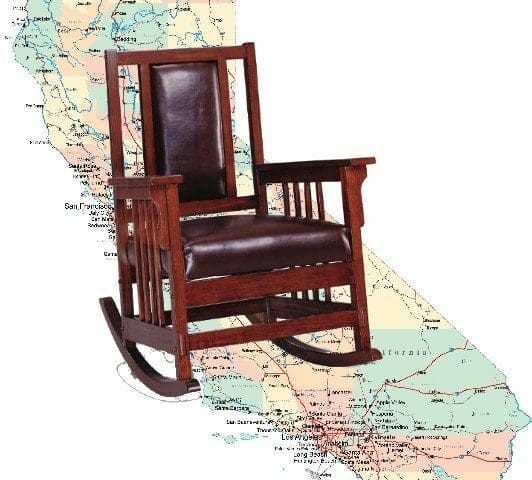
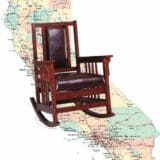
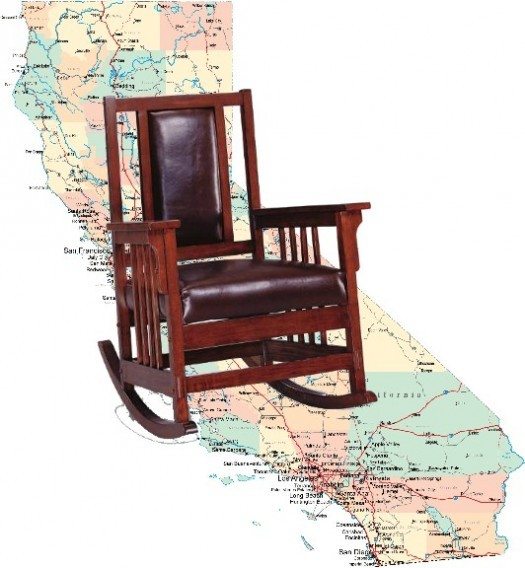 In the past decade the number of California workers with access to a retirement plan at work has plummeted. A recent study by The New School’s Schwartz Center for Economic Policy Analysis (SCEPA) shows that in 2009, 52.3 percent of California’s workers did not have access to an employer-provided retirement plan—representing a 6.5 percent rise over the previous decade in workers without pension access.
In the past decade the number of California workers with access to a retirement plan at work has plummeted. A recent study by The New School’s Schwartz Center for Economic Policy Analysis (SCEPA) shows that in 2009, 52.3 percent of California’s workers did not have access to an employer-provided retirement plan—representing a 6.5 percent rise over the previous decade in workers without pension access.
This increase poses a danger to the broader economy, which will suffer the destabilizing effects of mass retirement insecurity. Legislators can address this looming crisis with a fair, low-cost solution: opening existing, well-managed retirement systems to private sector employees.
SCEPA’s new statistics underscore the need for the California state legislature to once again take action on legislation based on my proposal. Titled The California Retirement Savings Act, the bill was introduced by State Senator Kevin DeLeon and passed the state senate in February.


 (This post first appeared on California Progress Report and is reposted here with permission.)
(This post first appeared on California Progress Report and is reposted here with permission.)
This November, California voters will have an opportunity to vote on a simple, yet important ballot initiative called Proposition 37 – the California Right to Know Act. If approved, it would require food sold in California supermarkets be clearly labeled if it has been genetically engineered.
What many probably don’t yet know is there is no clearer David versus Goliath fight on this year’s ballot. On one side, is a truly grassroots people’s movement that generated over a million signatures in just 10 weeks, easily qualifying for the November ballot. On the other stands the largest anti-union, pro-pesticide, agrichemical interests in the world dedicated to saying and spending whatever it takes to hide the fact that some of our most important crops are being genetically engineered in a lab without our knowledge or consent.
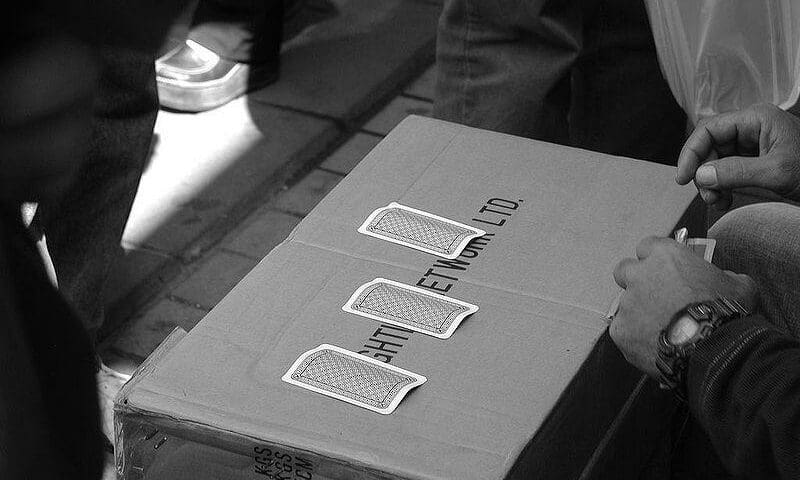

As more American cities sink into the quicksand of bankruptcy, a veritable Scapegoats’ Olympics has been inaugurated – crowd-pleasing blame games that usually point fingers at workers. Harold Meyerson was having none of it the other day, however, in an L.A. Times op-ed:
“From reading the voluminous accounts of the fiscal woes of Stockton and San Bernardino, you’d think that municipal unions and feckless city officials are primarily what led these cities down the path to fiscal ruin.”
For evidence, Meyerson quotes editorials and columns appearing in the O.C. Register and Sacramento Bee, both of which confidently laid the blame on the pensions of unionized public employees. Of course, the unchallenged narrative among the chattering classes has been all about spineless city governments caving in to unions whose greedy members expect to enjoy a paid retirement when they’re too old to work.
» Read more about: WebHot: Don’t Blame Workers for Bankruptcies »
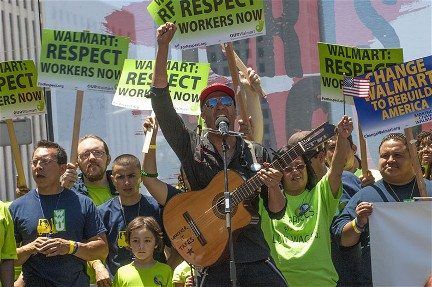
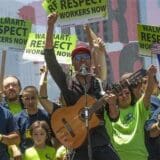
On June 30, I rode a bus from near the South Los Angeles site of Walmart to the Cornfield – the starting point for the largest rally ever held against the retail giant. It was on this bus packed with African American community activists that I came to fully understand why, as an African American pastor, I have for the last 10 years refused to shop at Walmart.
There has long been a debate in the community about whether low-income African Americans should shop at Walmart. Some people say that Walmart helps those who are struggling economically because they keep their prices low.
The truth is that Walmart is the leader at operating in its own best interest. And that interest – as we see with the enormous wealth of the Walton family – is to make as much money as possible.
There are several reasons why people who depend on the low prices and availability of Walmart should stop shopping there.
» Read more about: Walmart: Any Job Is Not Always a Good Job »